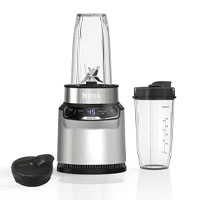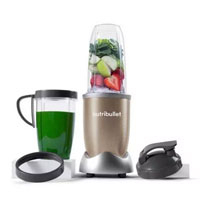Both Ninja and NutriBullet feature in our best blender guide, and we have tried both brands hands-on in our rigorous blender testing process. NutriBullet is best known for its bullet-style blender design which comes with a single-speed, one-serving blending cup that is easily switched on and off with just a twist. Ninja is more commonly known for its smart range of pre-set blenders, which come with buttons you can press to make a smoothie, crush ice, or chop fruits and vegetables. When deciding between the best NutriBullet and Ninja models, bear in mind that Nutribullet are best known for their portable blenders, while Ninja also has a range of larger blending appliances that take up more space, and cost more. We’ll talk you through the different product ranges below, and we have also directly compared two blenders to see how the brands compare, head to head. In our comparison, we tried out the NutriBullet Pro 900 (opens in new tab), and the Ninja Nutri 1000 Watt Auto-IQ blender (opens in new tab).
NutriBullet and Ninja deals
Explore our picks of the best NutriBullet and Ninja deals currently available.
Which is better: the NutriBullet or Ninja?
Below, you will see why I think a NutriBullet is a better buy than a Ninja. However, there are distinct differences, depending on what you are making. I go through them in detail, below. Power: 900W Cup Capacity: 32oz. Modes: 1 Colors: 17 RRP: $109.99 Power: 1000W Cup Capacity: 24 oz Modes: 3 Colors: 1 RRP: $99.99 For small or smoothie-sized blenders, choose a NutriBullet. Having tested NutriBullet vs Ninja blenders head-to-head, our NutriBullet came out on top. We gave a rare five-star rating in our NutriBullet Pro 900 Series Blender review, and while it is limited by its smaller single-serve capacity, it is the perfect choice for smoothies. For large portions, drinks or soups, choose a Ninja blender. However, if you want a larger blender, we would recommend turning to Ninja blenders. Designed to offer versatility and a selection of attachments to choose from, we really enjoyed reviewing the Ninja Professional Plus Kitchen System with Auto-IQ when we tested it. Nutribullet’s largest blender, as tested in our NutriBullet Blender Combo review, scored four stars in our review. Like the Ninja, it has a multi-serve and a personal cup, but it only has three blending speeds to choose from.
Nutribullet vs Ninja design differences
NutriBullet blenders are known for their simple and effective design. The base is compact and lightweight, and it requires you to screw the blade base onto your smoothie cup, press it down into the base, and twist it to start the blending process. To stop blending, you just need to twist it back to a neutral position. NutriBullet warns that its Pro 900 blender cannot be used for more than a minute at a time, presumably out of fear that the engine can overheat. However, we have used it for over a minute in the past and it did not have any issues. Keep the time limit in mind, but we wouldn’t list it as a deterrent. Ninja, however, has a preset mode called Auto-IQ, which is a feature you’ll find in some of the best food processors alongside their top blenders. This allows you to twist the smoothie cup into place and press from one of multiple modes. With the Ninja Nutri 1000, this includes Blend, Pulse, and Ultra Blend. These are pre-timed, meaning you can simply press the button and leave it to blend and automatically shut off once the cycle is finished.
NutriBullet vs Ninja: making a smoothie
NutriBullet produced the best results. I put my two blenders side-by-side to directly compare the results of two identical smoothies. I added the same amount of frozen mango, fresh pineapple (with the tough core included), curly kale, yogurt, and water to each cup, but because of the difference in cup sizes, the Ninja blender cup filled up far more. I added the blending lids and twisted both into the bases before pressing down the NutriBullet and twisting the cap into place, pressing the ‘Blend’ button on the Ninja as it seemed best suited to a smoothie of this type. The Ninja had a preset time of 50 seconds, and it pulsed multiple times to incorporate the fresh and frozen ingredients with no difficulty. The NutriBullet, by contrast, simply had a continuous blend cycle which I also left for 50 seconds. Neither blender had trouble slicing through the kale, frozen fruit, and pineapple core, and they came out very similar in color. However, there was a difference in the texture. The Ninja smoothie had more visible patches of green where the fibers of the kale had not completely been broken down, whereas the Nutribullet smoothie came out much more finely blended and it tasted very smooth. Overall, it was a better drinking experience. The smoothie was creamier and every ingredient had clearly been broken down, whereas in the Ninja there were small specs of kale that could have used more blending.
NutriBullet vs Ninja blenders: which should you buy?
I recommend NutriBullet. If you want a powerful bullet blender to make tasty smoothies, I would recommend picking up the NutriBullet Pro 900 blender (opens in new tab). It has two 32 oz to-go cups and lids, as well as a screw-on handle for easy drinking. Despite its marginally less powerful battery than the Ninja BL480D, it still was able to cut through kale stems, tough pineapple core, and frozen chunks of fruit with absolutely no difficulty. However, if you do like the idea of the Auto-IQ settings you’ll get with the Ninja Nutri-Blender Pro 1000W (opens in new tab), or if you are taken by the slightly lower price tag, it is also a top choice. The blender will allow you to leave your drink to blend hands-free, whereas the NutriBullet requires you to stand by and switch off the blender manually when you’re happy with your drink’s consistency. While the NutriBullet produced a better smoothie, it really is designed to do only this. The Ninja Nutri Pro 1000 Watt Auto-IQ Blender also has a pulse mode and a max blend mode, which I have used to make smoothie bowls in the past, and which is very effective on purely frozen ingredients. Looks-wise, I do think the NutriBullet has a more appealing color selection and overall appearance. The bullet design is extended down to the metallic base, and NutriBullet has also launched an exclusive range of fun colors with a matt base, which is perfect for strictly color-coordinated kitchens.
Larger NutriBullet and Ninja blenders
We have reviewed a number of NutriBullet and Ninja blenders, and while we put two personal-sized blenders head-to-head, if you are looking for a large or multi-serve blender, our reviews can still come in useful. When we reviewed the Ninja Professional Plus Kitchen System with Auto-IQ, the versatility was a big winner. It has a very powerful food processor attachment, with two levels of chopping blades that effectively cut through onions, dough, and more. Most importantly, the blending worked very well, even on soups. As our review of the Nutribullet Blender Combo shows, it is the brand’s attempt at a multi-serve, and while it’s good value for money, we did feel that it lacked the range of pre-sets and speeds you’ll find with a model from Ninja.
How we test our blenders
We’ve had hands-on testing time with many NutriBullet and Ninja models. When reviewing we crushed ice, blended frozen fruit into thick smoothie bowls, and made green smoothies from fibrous kale and spinach. Power: 1400W Cup Capacity: 72oz pitcher, 64oz bowl, two 24oz cups Modes: 5 presets RRP: $219.99 Power: 1200W Cup capacity: 64oz blender, 32oz cup, 24oz handled cup Modes: 3 speeds, pulse, extract RRP: $149.95 Cleaning a blender is a very important part of the user process, so we give props to blenders that can be cleaned in a dishwasher. However, some also come with self-cleaning settings that can prevent ingredients from sticking to the blades of the pitcher. We cleaned every blender by hand to see how easy this was, and if it felt safe. You can find out how Homes & Gardens tests blenders in our dedicated page. Our review and testing guidelines provide more insight into our process.











